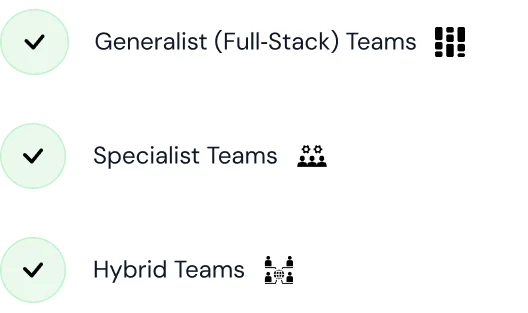Introduction
When prospective clients ask what a “typical” software development team looks like, the honest answer is that there’s no single model. Every company, every product, and every project is unique. While certain principles hold true, the proper team structure must always be shaped by specific project needs, organizational culture, and business goals. At Syberry, we’ve learned that a one-size-fits-all approach doesn't work; instead, each team must be thoughtfully designed from the ground up.
This article blends broad industry insight with Syberry’s experience in building custom software development teams. It explores our options to find the optimal team composition for software product development, tailored to each client's specific needs, rather than simply recycling identical team compositions repeatedly.
People First: Building the Right Foundation
When discussing team structures, it’s easy to slip into mechanical thinking, such as counting roles, sizing teams, and distributing responsibilities. However, the truth is that successful teams begin with the right people in key roles. Culture acts as the first filter: without a supportive organizational culture, no configuration of roles will function smoothly.
Even within the same culture, every team member brings a unique personality, and management’s role is to weave those personalities into a cohesive whole. That means more than just matching skills to job descriptions; it means aligning motivation and opportunity. A developer eager to try out a new technology, or a promising engineer ready for their first leadership role, may thrive if matched with the right project. When people are excited about their roles, collaboration and teamwork deepen, and innovation accelerates.
Team Roles in a Typical Software Development Project
Product Development Roles:
- Product Manager / Product Owner: Owns vision, backlog, roadmap. Represents stakeholders, ensures alignment with business requirements, and end‑user value.
- Scrum Master / Project Manager: Facilitates agile ceremonies, clears impediments, fosters effective communication, and ensures adherence to sprints and workflows.
Software Engineering Focus:
- Software Architect / Lead Programmer: Defines technical direction, ensures architectural integrity, and mentors developers.
- Back-End Developers: Build core functionality, handle business logic, databases, and architecture.
- Front-End Developers: Focus on UI, user experience, and client-side interactions.
- Full‑Stack Developers: Blend both roles to deliver across layers, especially in small teams or startups.
- UX Designers / UI Designers: Ensure optimal user interface and journey through research, prototypes, and design.
- QA Engineers / Automation Engineers: Responsible for quality assurance, running manual and automated tests to guarantee high-quality deliverables for end-users.
Supporting Roles in Team Structure:
- DevOps Engineer: Automates deployments, maintains CI/CD pipelines, and ensures scalability and speed of delivery.
- Business Analyst: Captures business goals, refines project requirements, and ensures alignment with stakeholders and technical teams.
- Team Lead / Tech Lead: Balances technical oversight with mentorship and coordination among developers.
Team Size: How Big Is Too Big?
There’s an old saying about “too many cooks in the kitchen,” and it applies perfectly to software development. Frameworks like Scrum suggest that 7–8 people are an ideal maximum for an agile software development team. That number is not arbitrary; it reflects the tipping point where communication overhead begins to outweigh the productivity of an app development process.
At Syberry, our experience confirms this guideline. For small to mid-sized projects, keeping product teams lean enhances adaptability, decision-making, and accountability. However, when projects grow larger, the answer is not simply adding more people to the same group. Instead, we need to consider the specific process models and create and combine multiple smaller teams, each aligned with clear goals and supported by formal processes to ensure alignment. This way, scalability doesn’t compromise focus or cohesion.

Specialization, Generalization, and the Hybrid Approach
A recurring debate in the software world is whether teams should favor generalists who can adapt to many tasks, or specialists who have specific skill sets and bring deep expertise. While there is a popular industry opinion that an agile team should not include specialized roles, in our experience, this approach works well only in a very small team of highly qualified people.
Deciding between generalists and specialists or a hybrid team structure depends on product complexity, scalability, and efficiency:
- Generalist (Full‑Stack) Teams: Team members can handle broad parts of the development lifecycle, providing flexibility and adaptability, but may lack deep expertise in specialized areas.
- Specialist Teams: Focused roles (e.g., front‑end, back‑end, DevOps, QA) ensure technical excellence but may introduce more handoffs and potential silos.
- Hybrid Teams: Often considered ideal, combining generalists who understand the full development picture with specialists who dive deep into specific areas.
For small startups, generalist full-stack developers offer the agility to move fast without rigid divisions. For larger or more complex projects, specialists like dedicated DevOps engineers or QA automation experts bring the depth needed to optimize performance and quality.
An effective software development team structure typically includes several core team member roles:
- Product Owner: Owns the product vision, balances stakeholder and business goals, manages the product backlog, and determines key deliverables. Especially vital in agile teams where requirements evolve frequently.
- Project Manager (or Product Manager/Scrum Master): Ensures the project progresses on time, within scope, and within budget, facilitating decision‑making and overseeing the development lifecycle.
- Software Engineers: Responsible for implementing functionality, spanning front‑end developers, back‑end developers, or full‑stack developers, depending on team size, complexity, and project requirements.
Beyond core software development team roles, several specialists enhance the team's capability:
- Business Analyst (BA): Bridges business requirements, stakeholder feedback, and technical implementation, ensuring the software development process aligns with real business needs.
- Quality Assurance Engineers (including Test Automation Engineers): Provide quality assurance, ensuring high-quality deliverables through iterative testing and continuous testing practices.
- DevOps Engineer: Supports automation, CI/CD pipelines, and streamlined software development lifecycle, enabling releases to be delivered quickly and reliably.
- Software Architect: Guides the technical direction, ensuring scalability, architectural integrity, code quality, and mentoring engineering staff.
- UX Designers / UI Designers: Focus on user experience (UX) and user interfaces, conducting research, prototyping, wireframing, and designing intuitive workflows for end‑users.
Syberry often combines the approaches of generalist and specialist teams, embedding roles such as engineering and product management within the team, while drawing on specialized groups for QA or DevOps. Cross-functional teams with diverse skill sets are essential, especially for complex projects or startups. These teams integrate engineering, UX, QA, and DevOps professionals to ensure all aspects of the software product, from functionality to user experience, are handled cohesively. This hybrid team model strikes a balance between efficiency and expertise, providing a seamless blend of both. It ensures dedicated teams can solve problems end-to-end while still accessing deep domain knowledge when needed.
Qualifications: The Pyramid Model
Another crucial factor in team structure is experience. A team composed entirely of senior engineers might sound like a dream, but in reality, it can backfire. Too many senior voices can lead to endless debates (analysis paralysis) about frameworks or architectural choices.
Syberry has found that high-performing teams resemble a pyramid structure, with a few senior leaders at the top providing guidance, supported by mid-level and junior engineers who handle the majority of the execution. This model fosters momentum while still allowing for strategic decision-making. It also fulfills a broader responsibility: training less experienced developers so they can grow into future leaders. Without this, the industry risks starving itself of tomorrow’s senior talent.
Of course, for this model to succeed, management must ensure that competence, not seniority or authority, guides decision-making. In healthy team cultures, ideas are judged by merit, and everyone feels secure contributing.

Organizing for Success: Frameworks and Workflows
Regardless of how teams are staffed, their organization and methodology ultimately determine whether they succeed. Agile methods, such as Scrum, dominate modern development because they emphasize iterative progress and adaptability. Other methodologies, such as Lean, stress the elimination of waste and the amplification of learning.
Modern software engineering teams benefit from structured methodologies:
- Agile Methodology (Scrum): Organizes work into sprints, facilitates iterative development, enables effective communication via daily stand-ups, incorporates stakeholder feedback, and encourages self‑managed, cross‑functional teams.
- Lean Development Emphasizes the elimination of waste (e.g., excessive meetings, overengineering), amplifying learning through rapid feedback, empowering the team, and optimizing the entire process.
In practice, most companies adopt a blended model, choosing elements of multiple frameworks that best suit their culture and project scope. What matters most is that workflows remain clear, decision-making authority is defined, and the team has the freedom to focus on problem-solving rather than bureaucracy.
Scaling and Splitting Teams
As projects scale, organizations face the challenge of dividing work effectively. Sometimes it makes sense to split by technical specialization: one group focusing on automation, another on user experience. In other cases, dividing by product features or domains works better, with each sub-team becoming a dedicated, self-managed unit responsible for its own deliverables.
Dividing teams based on project needs can enhance focus:
- Create specialist sub-teams for user experience, automation, performance, and other relevant areas.
- Use centers of excellence to develop deep technical capabilities and foster knowledge sharing across teams and locations
In some contexts, companies turn to outsourcing to either extend their capacity or access skills not available in-house. While outsourcing can introduce risks such as communication gaps or cultural mismatches, these can be mitigated by embedding product owners or business analysts close to the outsourced teams.
When considering dedicated in‑house teams vs outsourced solutions, weigh:
- In-house teams offer deeper alignment with product vision, closer communication, and team cohesion.
- Outsourced teams may provide cost flexibility and specialized skills. Co-locating a product owner or business analyst with outsourced teams can reduce ambiguity.
The most successful arrangements often blend in-house leadership with outsourced execution.

The Human Side of Team Structures
Ultimately, while roles, sizes, and processes all matter, what really determines success is the human dimension. Teams thrive when people feel motivated, supported, and aligned with the project’s vision. At Syberry, we emphasize matching individual aspirations with project opportunities. Giving a junior engineer their first chance to lead, or letting a developer explore a new technology stack, can transform a team from competent to inspired.
Equally important is fostering a culture where opinions are heard and ideas are tested on their merits, not on hierarchy. This culture of respect and collaboration often matters more than the exact distribution of roles or the choice of framework.
Conclusion
Building an ideal software development team structure involves more than assembling roles: it’s about ensuring the team is organized, empowered, and equipped to deliver high-quality, user-centered software efficiently. By balancing specialists and generalists, embracing agile frameworks, optimizing team size, and fostering cross-functional collaboration, organizations can increase adaptability, streamline workflows, and align product development with core business goals.
Whether you're in startups aiming for flexibility or managing complex projects requiring specialized expertise, this approach to structuring teams ensures clarity of team roles, effective communication, and continual delivery of value. At Syberry, we undergo a rigorous process to create the ideal team to develop every client's unique product or system, but the most important thing to remember is that people are central to this process.
Start with identifying the right people, and then work backward to design the team. Utilize iterative sprints, clear decision-making authority, empowered teams, and automated workflows to create an environment where quality, scalability, and project success become the norm.



